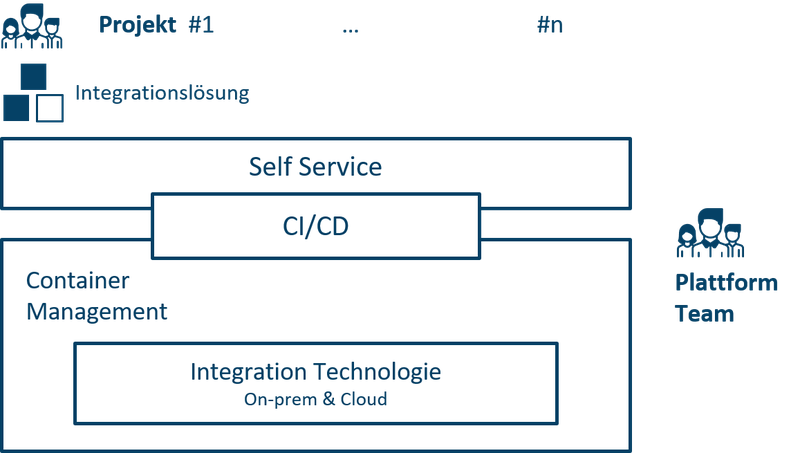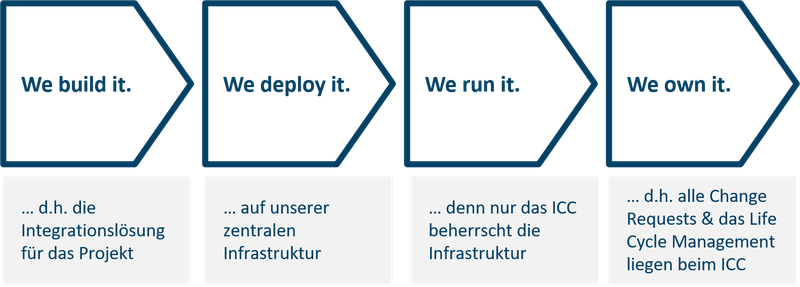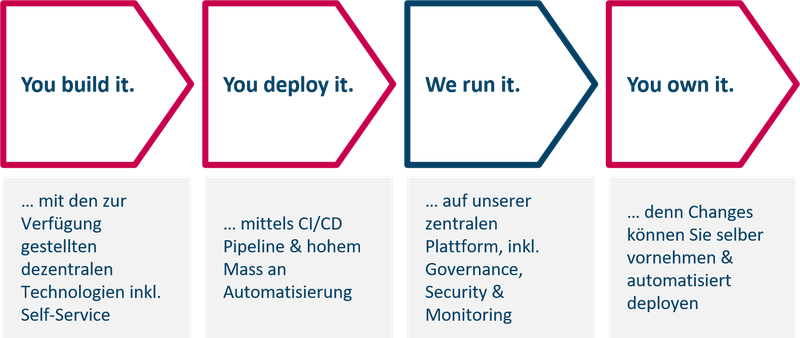
Peter Graef
Managing Partner
Eine moderne Integrationsstrategie ist ein wichtiges Element in IT-Strategien.
Die Digitalisierung führt zu hyperverteilten Systemen, Applikationen und Services – und alles muss integriert werden. Im Folgenden zeigen wir auf, warum Sie die heutigen zentralen Integrations-Ansätze überdenken und durch dezentrale Technologien, Prozesse und Organisationsformen erneuern müssen.
Autor: Peter Graef
Viele Unternehmen in der Schweiz haben heute zentrale Integrationsinfrastrukturen: JMS Messaging, MFTs, ESBs, BPM-Engines usw. Diese Technologien und die dazugehörigen Prozesse und Organisationsformen stammen aus einer Zeit, in der man die Kontrolle über ausufernde point-to-point-Integrationen (sogenannte Spaghetti-Interfaces) gewinnen wollte. Zentrale Integration war damals die Lasagne Antwort: Gut geordnete Schichten von Integrations-Technologien mit Governance-Prinzipien und Prozessen. Organisiert wurde dies durch eine zentrale Einheit, das CoE (Center of Excellence) oder ICC (Integration Competence Center). Endlich gab es Übersicht und Kontrolle. Endlich funktionierte Integration als gut eingebettetes Element im Bebauungsplan der IT-Strategie.

Fast forward ins Hier und Jetzt: Heute gibt es gute Gründe für eine Weiterentwicklung der Integrationsstrategie. Damit sollen die gestiegenen Anforderungen an Business-Agilität, Innovation und Time-to-Market adressiert werden. Darüber hinaus gibt es zwei spezifische Treiber des Wandels:
Systeme, Applikationen und Services werden zahlreicher, sie werden immer feingranularer und müssen alle integriert werden. Microservices-Architekturen. Cloud. Ecosystems. You name it. Im Klartext: Es gibt immer mehr zu integrieren und es gibt immer mehr Arbeit für die Spezialisten im zentralen ICC. Das führt bei vielen Unternehmen dazu, dass Integration auf dem kritischen Pfad der Projekte steht. Integration wird zum Engpass im Projektgeschäft.
Erschwerend kommt dazu, dass die Budgetierung von Integration häufig in bzw. durch die Projekte passiert, das heisst die Projekte bezahlen für Integration und beziehen die Spezialisten (intern oder extern) aus dem ICC. So wird verhindert, dass die FTEs (Full Time Equivalent) und damit die Kosten im ICC steigen. Allerdings wird die Koordination massiv erschwert und das ICC wird zum Spielball der sich ständig ändernden Projektpläne und Ressourcen-Anforderungen. Im schlimmsten Fall horten die Projekte selbst Integrationsexpertise, um vom ICC unabhängig zu sein und umgehen die zentralen Plattformen wo immer möglich.
Mit API-Management, Cloud Native Services oder event-driven Integration können heute Integrationsszenarien realisiert werden, welche vor einigen Jahren überhaupt nicht möglich waren. Dadurch eröffnen sich neue Perspektiven auf die dazugehörigen Prozesse und Organisationsformen.
Mit diesen technologischen Weiterentwicklungen ging der Aufstieg des IT-Engineering einher. Nerds sind heute cool. Agile und DevOps haben zu signifikantem Empowerment von IT geführt. Gartner und andere Analysten bringen zwar die Rolle des ‘Citizen Developers’ oder ‘Citizen Integrators’ ins Spiel, doch das Gegenteil ist der Fall: IT wird immer komplexer und immer technischer. Die neue IT-Engineering-Generation begrüsst diese Entwicklung und hat kein Interesse an zentralen on-premises Integrations-Tools mit proprietären Technologien, die man über eine GUI Konsole managen kann. Gefragt sind stattdessen moderne Technologien und Produkte, die komplexe Integrations-Patterns ermöglichen und hohe Ansprüche an die IT-Engineers stellen, z.B. event-driven Integration mit Kafka, am liebsten in der Cloud.
Wer heute die enorm steigende Workload für Integration bewältigen bzw. das grosse Nutzenpotenzial von moderner Integration ausschöpfen will, dessen Integrationsstrategie muss:
Das Ziel von agiler Integration ist es, die Produktivität der Entwickler in den Projektteams zu erhöhen und Lösungen zu realisieren, die Systeme, Applikationen und Services wirklich entkoppeln.
Agile Integration ist kein Produkt. Obwohl es natürlich auch um Technologien geht. Agile Integration heisst, dass Integrationslösungen dezentral in den Projekten entwickelt werden. Sie werden danach samt ihren Runtime-Anforderungen in Containern verpackt und via hoch automatisierten CI/CD Pipelines auf die zentralen Infrastruktur-Plattformen des Unternehmens deployed.

Eine recht einprägsame Formulierung in Anlehnung an den alten DevOps Spruch «you build it, you run it» könnte in Bezug auf Integration wie folgt lauten.
Heute sagt das ICC-Team zum Projekt-Team, das eine Integrationslösung braucht:

Morgen sagt das Agile-Integration-Plattform-Team zum Projekt-Team:

Insbesondere der letzte Punkt hat enorme positive Auswirkungen, weil das Lifecycle Management der Integrationslösungen von der zentralen Organisation entkoppelt wird. Dadurch werden jegliche Hand-Offs und Wartezeiten sowie Ticket-basierte Kommunikation obsolet.
Natürlich sind damit nicht alle Herausforderungen adressiert. Mit Agile Integration wird:
Eine moderne Integrationsstrategie adressiert die Herausforderungen von heutigen zentralen Technologien, Prozessen und Organisationsformen. Sie formuliert einen Wertbeitrag für die kritische Fähigkeit, schneller und besser zu integrieren. Das Nutzenpotenzial ist gewaltig.
Do you need to rethink your integration strategy?